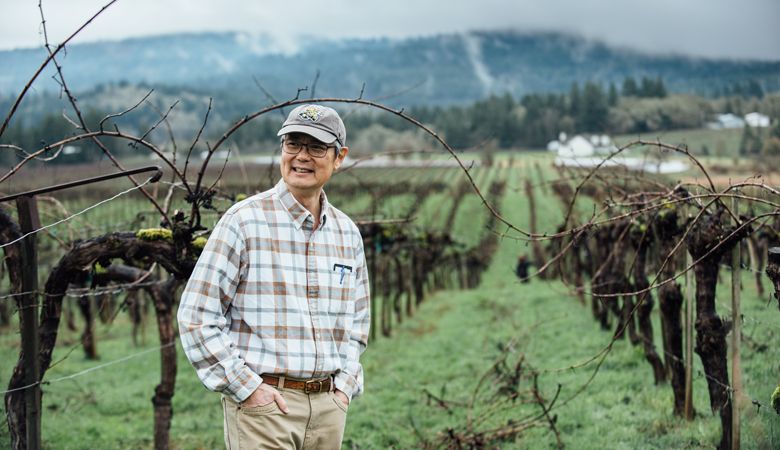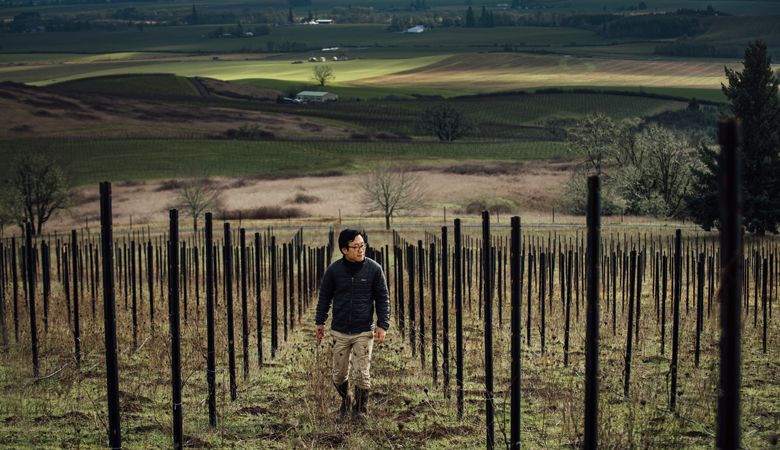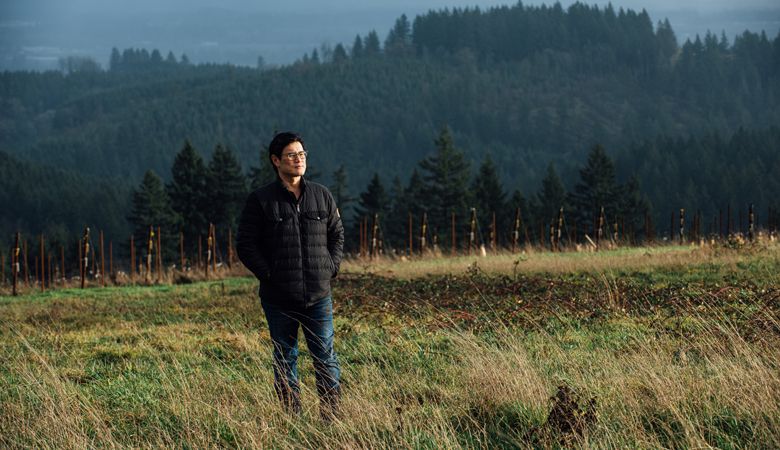Diverse Landscape
Asian Americans expand Oregon’s wine horizon
Story by Sophia McDonald • Photos by Kathryn Elsesser
Diversity resulting from blending wines from different blocks or vintages often makes for superior beverages — ones able to capture the imagination inspire engaging conversation and excite the senses.
A similar theory holds true for welcoming people with diverse backgrounds and life experiences into any professional field. Different skills, attitudes, perspectives and lessons from history add new ideas and information and have the potential to make a whole industry better.
There’s been much talk in recent years about the extremely low rates of winery ownership among black Americans, the need to welcome women into the winery and the desire to find pathways for Latinx people to move up from the stereotypical role as vineyard workers into ownership and management positions. But Asian Americans are a group not often discussed. We talked to three professionals about their experience in Oregon’s wine community, what they enjoy about working in the state and what they bring to the local wine industry.
Mark Chien, Oregon State University
Wine wasn’t part of Mark Chien’s life until his family made a temporary move to Germany for his father’s sabbatical. “We just happened to have friends who lived near a vineyard and had family in the wine industry,” he said. “I loved the vineyards. I loved walking around eating the grapes. I got sucked in by the romance.”
His father, a research scientist, encouraged all his kids to pursue careers in similar fields. “That’s the Asian stereotype. We’re supposed to be doctors and scientists,” Chien said, who was raised in a Chinese American household. “They were no different in their expectations.” He studied psychology as an undergraduate, but soon after graduation, he took a sharp left turn and attended the University of California-Davis to study viticulture. Afterward, he spent more than two decades managing vineyards in New York and Oregon, including 15 years at Temperance Hill Vineyard in the Eola-Amity Hills AVA.
Chien has never regretted it. “It just led me down different paths to meet different people and visit beautiful places around the world, and do good, honest work. And I can’t think of anything more intellectually challenging than farming. Every day is full of questions and few answers, and you just try and do the best you can to produce really good grapes — or meet whatever the challenge is, whether it’s Mother Nature or government-imposed tariffs.”
Chien eventually accepted a position as state viticulturist at Penn State Cooperative Extension, where he worked 15 years. In 2014, he returned to the Northwest to lead the Oregon Wine Research Institute at Oregon State University. Today, he’s head of the Marion County Extension Service office.
The quality of Oregon wine has improved markedly during his 40 years in the industry, he says, which is exciting in and of itself. But Chien was part of some of the early initiatives to build up the industry across the board in the ’70s and ’80s, and says it’s satisfying to see that work pay off now. “Many of the institutions and plans we developed back (then) have borne fruit in the quality and the reputation of the wine. It’s neat to see everything come together like that.”
The ability to engage in long-term thinking is certainly not unique to Asian Americans, but it is one of the gifts people from Eastern cultures contribute to the industry. “I think Asians culturally bring a longer-term vision to everything they do,” Chien said. “There’s less of a need for instant gratification. When you’re dealing with perennial crops — Asians are well-suited to that. They’re willing to look ahead at the potential gains from doing something now and having it be fruitful somewhere in the future.”
Tai-Ran Niew, Niew Vineyards
Born in the U.K., Tai-Ran Niew grew up in a family that split its time between London and Singapore. Niew earned a Ph.D. in aeronautical engineering but ended up working as an investment banker. He called it quits just a year before the economic crash in 2007.
As he contemplated his next move, he felt drawn to wine. It provided a respite from the break-neck pace of banking and a way to re-engage with science. “As you go into the culture of wine, you touch on history. You touch on aesthetics. It bridges so many disciplines,” he added. “That’s how I fell in love with it.”
Niew’s goal became to buy a vineyard. He spent some time traveling the world, working in vineyards and studying wine. When it came time to purchase a property, his wife was already working in the U.S., so it was an easy decision to live stateside. In 2015, he found the perfect vineyard site, 80 acres, in the Chehalem Mountains. So far, he has five acres planted to Chardonnay. His first vintage (made primarily with purchased fruit) should be available in 2021.
Although Niew acknowledges climate change is “throwing a curve ball” at Oregon’s wine industry, he still believes it’s a place that can produce some truly elegant wines on par with those from the best regions of Europe. Oregon’s short wine history is also a draw. “Anyone coming in can write their own story. You can basically carve your own path and put your stamp on it. There’s this sense of freedom to do whatever you feel like doing. That’s rare.”
The history of winemaking in Europe is long, he notes, but the traditions and appreciation surrounding craft, art and food in Asia are millennia longer. “Even if it’s not specifically wine-related, there’s a lot culturally we can bring to wine, which is a craft and an art, and that’s where it can get very interesting,” he said. “There’s a natural tendency when you go into wine — given how much of it is rooted in France and Italy and Germany and the U.K. — that you forget that you may have something to bring to the table, too, from other cultures.
To other Asian Americans thinking about entering winemaking, he implores them, “Think about what you can bring from your own culture that might help you end up with a more interesting product.”
Junichi Fujita, Winegrower
Junichi Fujita immigrated to the U.S. from Japan when he was 8. He was raised by his mother, who was not a wine drinker. “Somehow, when I was around 18, I started picking up wine books. I wanted to sound sophisticated or something,” he said with a laugh. “I was a teen that had really diverse hobbies: roasting my own coffee, working on cars, building computers. Wine was one of these things. It was the hobby that stuck with me.”
Fujita studied physics and did academic research for a few years, but the pull of wine eventually became too strong. He earned a degree in viticulture and enology at the University of California-Davis with the goal of becoming a winemaker.
Those were the early days of the natural wine movement, and Fujita was fascinated by the new range of flavors and producers. By chance, he landed a job with the Radikon family in Friuli, one of first families to revive the skin-contact orange wines once common in the region. Subsequently, he worked harvests in Australia, France, New Zealand and Germany.
It wasn’t long after he returned to California when his interest in natural farming developed to the point where it was almost equal to his passion for winemaking. He started looking for land in California, but the state was in the middle of an extended drought, which left him questioning the long-term viability of growing grapes in the state. He began looking north. He landed a job with Résonance, the winery headed by former Louis Jadot winemaker Jacques Lardière, allowing him more time to search for land. In 2015, he found an ideal site with 30 acres in the McMinnville AVA. Five acres are now planted to a combination of Pinot Noir and Gamay.
Fujita, like Niew, sees a strong link between winemaking and art. His perspective is slightly different, though. “As a winemaker, everyone is trying to create something that is perfectly balanced, that has this very perfect symmetry,” he said. “They’re always striving for that platonic ideal of a wine that is free of faults.”
His ideal is similar to the Japanese concept of wabi-sabi, which finds beauty in unavoidable imperfection. “For the Japanese, it’s not the full moon that’s the most beautiful. It’s always the day before or the day after when it’s a tad off of perfect. In that way, I see and embrace wine in a different way. When you have something that is really beautiful and symmetrical, it takes your breath away because you can see all the painstaking effort that went into creating something so perfect. But after you’re in awe, it leaves me, at least, a little cold. Whereas something that has that perfect imbalance, something that can bring warmth and familiarity in a way, has a beauty all its own.”
In the end, he says, we are all imperfect beings. A wine that speaks to that acceptance, giving credence to our flaws and faults as humans, may be the most perfect wine of all.













